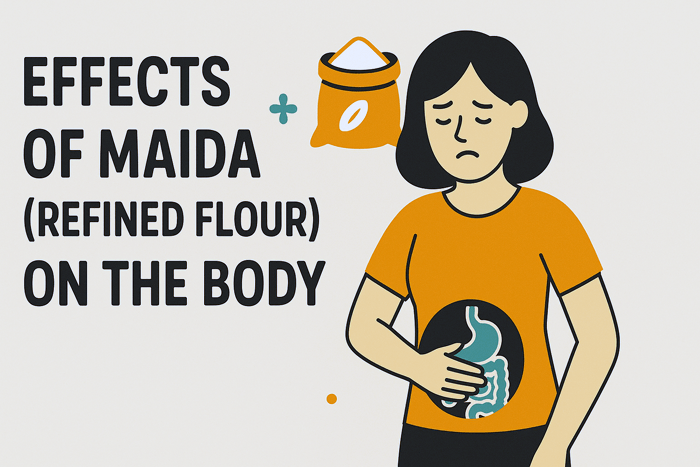Maida, commonly known as refined flour, is a staple in many Indian kitchens and an essential ingredient in popular food items like bread, biscuits, cakes, pastries, noodles, and samosas. While it may lend softness, fluffiness, and shelf life to food, the real cost of consuming maida regularly is paid by our health.
In this blog, we explore how maida affects the human body — from your blood sugar to your digestive system — and why it’s wise to limit its intake or seek healthier alternatives.
What is Maida?
Maida is made by milling wheat and removing the bran (fiber) and germ (nutrients), leaving behind the starchy endosperm. This fine white flour is then bleached to give it a pristine white appearance. While this process increases the shelf life and visual appeal, it also strips away most of the natural nutrients present in whole wheat.
1. Blood Sugar Spikes and Increased Risk of Diabetes
Maida has a high glycemic index (GI), which means it rapidly breaks down into glucose after consumption. This leads to sudden spikes in blood sugar levels, forcing the pancreas to release large amounts of insulin.
Over time, repeated insulin spikes can cause insulin resistance, paving the way for type 2 diabetes. This is particularly alarming in a country like India, which already has one of the highest numbers of diabetic patients in the world.
Tip: Replace maida with whole grain flours like whole wheat, millet, or oats to maintain blood sugar stability.
2. Poor Digestive Health and Constipation
Since maida is devoid of fiber, it moves slowly through the digestive tract. This can lead to issues such as:
- Constipation
- Bloating
- Acidity
- Indigestion
Fiber plays a crucial role in gut health by adding bulk to stool and feeding good gut bacteria. A maida-rich diet deprives your body of this essential component.
3. Weight Gain and Obesity
Maida is calorie-dense but nutrient-poor. It gets digested quickly and leaves you feeling hungry soon after eating. This can lead to overeating, especially of processed foods like burgers, pizzas, and bakery products.
Excess consumption of such empty calories contributes directly to:
- Increased belly fat
- Higher BMI (Body Mass Index)
- Slower metabolism
The lack of satiety and nutrients can also promote cravings for sugary and salty snacks — compounding the issue further.
4. Acidity and Gut Inflammation
Maida-based foods are often deep-fried or loaded with sugar, salt, and preservatives — making them highly acid-forming. When consumed frequently, they can irritate the stomach lining and cause acidity or gastric inflammation.
Over time, these irritations can result in more serious gastrointestinal issues like:
- Leaky gut syndrome
- Acid reflux
- Ulcers
5. Nutritional Deficiency and Fatigue
Because maida is heavily processed and lacks essential nutrients such as fiber, B vitamins, iron, and magnesium, it offers little to no nourishment to the body. A diet high in maida can lead to:
- Chronic fatigue
- Poor immunity
- Hair fall and dull skin
- Anemia
Unfortunately, many children and adults unknowingly consume a maida-heavy diet through biscuits, bread, noodles, and packaged snacks — slowly leading to deficiencies over time.
6. Hormonal Imbalance
There’s growing research that links refined carbohydrate consumption to hormonal imbalances, especially in women. High maida intake has been associated with:
- Increased PCOS symptoms
- Irregular periods
- Acne
- Mood swings
When the body’s insulin response is constantly challenged by high-GI foods, it disrupts hormonal harmony — something especially problematic for teenagers and women of reproductive age.
7. Addictive Eating Behavior
Maida has little flavor on its own, but it forms the base of foods that are high in fat, salt, or sugar — all of which stimulate the brain’s reward system. This can lead to food addiction-like behavior, where you find yourself reaching for a biscuit, cake, or instant noodles even when you’re not truly hungry.
This “pleasure trap” creates a cycle of emotional and binge eating, which makes weight loss and lifestyle changes more difficult.
Healthier Alternatives to Maida
The good news? There are several healthier options available:
- Whole wheat flour (atta)
- Almond flour
- Oats flour
- Ragi (finger millet) flour
- Besan (gram flour)
- Jowar (sorghum) and Bajra (pearl millet)
These flours are rich in fiber, protein, and essential nutrients. Not only do they keep you full longer, but they also stabilize your blood sugar and support gut health.
Final Thoughts
Your body deserves better than maida. Make the switch to wholesome ingredients — your future self will thank you.
If you’re unsure what diet suits your body best, especially if you’re struggling with weight gain, fatigue, or lifestyle diseases, consider getting a personalized nutrition plan based on your DNA.
📞 Contact DNA Diet Clinic by Dr. Rushikesh Trivedi for a science-backed, customized approach to your health and long-term wellness.
Call: 099133 30931


